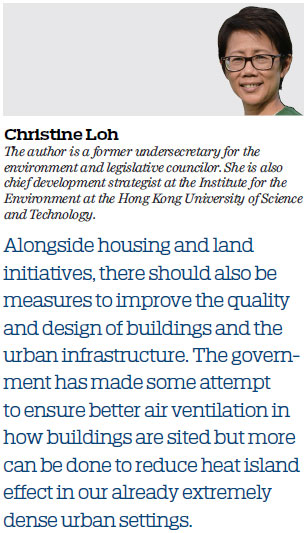The govt can do so much more to bring back harmony
Updated: 2019-10-29 07:41
By Christine Loh(HK Edition)
The chief executive’s policy address was especially hard to write this year. The continuing protests since June have thrown the city into deep political division, making the construction of the annual address extremely challenging.
It was perhaps bound to satisfy no one in Hong Kong’s annus horribilis. Nevertheless, there were themes in the address about government attitude that should be supported, such as promoting dialogue with the community, grasping public sentiments accurately, being more open and accommodating, and listening patiently.
The public should also not ignore the 220 new initiatives that have been made by Chief Executive Carrie Lam Cheng Yuet-ngor. There is much that the administration can rearticulate and reshape into narratives that people would welcome and support.
First, a word about process.
The tradition in Hong Kong has been for the government to invite the public to send in ideas, as well as for departments to make proposals on what they wish to do in the coming year. What ends up being pledged in the policy address would need to be funded, which then has to be taken up in the following year’s budget.

The chief executive’s address is usually quite long and peppered with many items across all the policy areas since it has contributions from across the bureaucracy. Policy addresses sound and read like laundry lists because the government desperately need better speechwriters, especially when the tradition is to throw in so many bits and pieces.
Lam tried to depart from the menu approach this year. The speech, which she delivered via a recorded video rather than at the legislature as she was heckled by the opposition and had to leave the chamber, focused mainly on housing and land supply, which she believed to be the source of public grievance. The other areas of policy were published in a long supplement that both provided updates on previous initiatives, as well as putting forward new ones.
Media reports and public reactions were harsh and unforgiving – many said the policy address did not help to solve Hong Kong’s current crisis. While the perception was that the speech did not alleviate public discontent tied to the protests, there were solid nuggets that could be used to address long-standing policy gaps. After all, despite the city’s acute political woes, what can be done in the interest of the community must still go ahead.
In the supplement, the sections on creating a more diversified economy, nurturing talent and improving livelihood could be weaved into a coherent vision for a better life for the people, alongside the CE’s pledge to provide more housing.
The fact is, the government has to free up and provide land for all kinds of development and purposes, and it has to ensure the use of land as a resource is fairly shared. This needs to be better articulated.
Alongside housing and land initiatives, there should also be measures to improve the quality and design of buildings and the urban infrastructure. The government has made some attempt to ensure better air ventilation in how buildings are sited but more can be done to reduce heat island effect in our already extremely dense urban settings.
The government could initiate dialogue with built environment professionals, academics and non-government organizations to reimagine the city, and the younger generations are very keen to participate in such discussions.
There is a huge pool of talent in Hong Kong that can be encouraged to participate. More than civil servants, they are able to combine disciplines to showcase how to design, build or retrofit buildings and districts to integrate “smart” infrastructure with resource efficiency and environmentally friendly outcomes. The government has yet to tap into young people’s support for the environment to use it as a unifying narrative.
An underlying disillusionment across society is how hard it is for people to work with the government because of bureaucratic stasis or a close-minded attitude. The bureaucracy has to let go of its silo mindset. In fact, the current and future chief executives should appoint principal officials who can adopt multidisciplinary approaches and exercise power to ensure the civil service structure is able to work across policies. In short, they need to think outside the box.
Specific examples include how to combine building retrofits in Hong Kong with achieving energy and water saving with building safety. The policy address showed HK$7.5 billion ($956.6 million) would be spent on building safety – how can the targeted buildings also achieve resource efficiency and lower-carbon outcomes? How might Hong Kong’s built environment talents be unleashed to improve specific challenging areas in districts?
In arts and culture, the policy address earmarked some HK$22 billion for hardware and funds for supporting arts groups. What the government has not acknowledged is that Hong Kong’s young people need to have reasonably priced venues and activities for the things they like to do, such as outdoor music concerts, where they can let their hair down. Young people need outlets for their energy, and for their talent to flourish – something sorely lacking in Hong Kong.
People in the arts and entertainment sector, together with young people, can also be in dialogue with the government on how events could be organized that they will enjoy. Hong Kong has a strong pool of entertainment talent, many of whom are staging large events outside the territory because there are so many limitations locally.
Dialogues, which the CE is pushing to deal with an immediate exigency, don’t have to be viewed only from the vantage point of resolving conflict arising from the protests. It can be designed to engage Hong Kong’s talent pools to help everyone, including the government, to envision opportunities and rebuild trust.
(HK Edition 10/29/2019 page8)
